Experimental Studies of Microchannel Tapering on Droplet Forming Acceleration in Liquid Paraffin/Ethanol Coaxial Flows
Abstract
1. Introduction
2. Materials and Experimental Set-Ups
3. Liquid Paraffin–Ethanol Coaxial Flow at the Convergence Angle
3.1. State Diagram about the Dripping-to-Jetting Transitions
3.2. Droplet Diameter in Dripping Mode
3.3. Droplet Diameter in the Jetting Mode
4. The Role of Convergence Angle, and
4.1. The Influence of Microchannel Tapering on the State Diagram
4.2. The Influence of Microchannel Tapering on Droplet Generation Characteristics in the Dripping and Jetting Modes
4.2.1. Dripping Mode
4.2.2. Jetting Mode
5. Conclusions
- (1)
- In the straight-tube () coaxial stream, the experimental results of the Dripping-to-Jetting transition, flow patterns, and droplet characteristics are consistent with the data and fitting laws in the related literature.
- (2)
- The tapered microchannel () changes the state diagram of the liquid paraffin/ethanol coaxial in the – space. The Dripping mode is not affected, and the Jetting regime is the most compressed by the emerging Threading mode at a large .
- (3)
- The tapered microchannel () causes little change about the droplet forming processes in the Dripping mode, which is different from that of the Jetting mode. In the Jetting mode, the size of the droplet decreases as the tube diameter reduces by tapering, which is exactly the opposite for the droplet forming frequency. The droplet forming frequency grows quickly as the tube diameter reduces, .
Author Contributions
Funding
Conflicts of Interest
References
- Teh, S.Y.; Lin, R.; Hung, L.H.; Lee, A.P. Droplet microfluidics. Lab Chip 2008, 8, 198–220. [Google Scholar] [CrossRef] [PubMed]
- Xu, Q.B.; Hashimoto, M.; Dang, T.T.; Hoare, T.; Kohane, D.S.; Whitesides, G.M.; Langer, R.; Anderson, D.G. Preparation of Monodisperse Biodegradable Polymer Microparticles Using a Microfluidic Flow-Focusing Device for Controlled Drug Delivery. Small 2009, 5, 1575–1581. [Google Scholar] [CrossRef] [PubMed]
- Demello, A.J. Control and detection of chemical reactions in microfluidic systems. Nature 2006, 442, 394–402. [Google Scholar] [CrossRef] [PubMed]
- Zhao, L.B.; Pan, L.; Zhang, K.; Guo, S.S.; Liu, W.; Wang, Y.; Chen, Y.; Zhao, X.Z.; Chan, H.L. Generation of Janus alginate hydrogel particles with magnetic anisotropy for cell encapsulation. Lab Chip 2009, 9, 2981–2986. [Google Scholar] [CrossRef]
- Martinez, C.J.; Kim, J.W.; Ye, C.; Ortiz, I.; Rowat, A.C.; Marquez, M.; Weitz, D. A microfluidic approach to encapsulate living cells in uniform alginate hydrogel microparticles. Macromol. Biosci. 2012, 12, 946–951. [Google Scholar] [CrossRef]
- Akbari, S.; Pirbodaghi, T. Microfluidic encapsulation of cells in alginate particles via an improved internal gelation approach. Microfluid. Nanofluid. 2014, 16, 773–777. [Google Scholar] [CrossRef]
- Zheng, B.; Tice, J.D.; Ismagilov, R.F. Formation of Arrayed Droplets by Soft Lithography and Two-Phase Fluid Flow, and Application in Protein Crystallization. Adv. Mater. 2010, 16, 1365–1368. [Google Scholar] [CrossRef]
- Wang, Q.; Liu, S.; Wang, H.; Zhu, J.; Yang, Y. Alginate droplets pre-crosslinked in microchannels to prepare monodispersed spherical microgels. Colloids Surf. A Physicochem. Eng. Asp. 2015, 482, 371–377. [Google Scholar] [CrossRef]
- Cygan, Z.T.; Cabral, J.T.; Beers, K.L.; Amis, E.J. Microfluidic platform for the generation of organic-phase microreactors. Langmuir Acs J. Surf. Colloids 2005, 21, 3629. [Google Scholar] [CrossRef]
- Hatch, A.C.; Fisher, J.S.; Pentoney, S.L.; Yang, D.L.; Lee, A.P. Tunable 3D droplet self-assembly for ultra-high-density digital micro-reactor arrays. Lab Chip 2011, 11, 2509–2517. [Google Scholar] [CrossRef]
- Liu, H.; Zhang, Y. Droplet formation in a T-shaped microfluidic junction. J. Appl. Phys. 2009, 106, 887. [Google Scholar] [CrossRef]
- Chiarello, E.; Gupta, A.; Mistura, G.; Sbragaglia, M.; Pierno, M. Droplet breakup driven by shear thinning solutions in a microfluidic T-junction. Phys. Rev. Fluids 2017, 2, 123602. [Google Scholar] [CrossRef]
- Pan, D.; Liu, M.; Li, F.; Chen, Q.; Liu, X.; Liu, Y.; Zhang, Z.; Huang, W.; Li, B. Formation mechanisms of solid in water in oil compound droplets in a horizontal T-junction device. Chem. Eng. Sci. 2017, 176, 254–263. [Google Scholar] [CrossRef]
- Zhang, Q.; Li, H.; Zhu, C.; Fu, T.; Ma, Y.; Li, H.Z. Micro-magnetofluidics of ferrofluid droplet formation in a T-junction. Colloids Surf. A Physicochem. Eng. Asp. 2017, 537, 572–579. [Google Scholar] [CrossRef]
- Cubaud, T.; Mason, T.G. Capillary threads and viscous droplets in square microchannels. Phys. Fluids 2008, 20, 053302. [Google Scholar] [CrossRef]
- Fu, T.; Wu, Y.; Ma, Y.; Li, H.Z. Droplet formation and breakup dynamics in microfluidic flow-focusing devices: From dripping to jetting. Chem. Eng. Sci. 2012, 84, 207–217. [Google Scholar] [CrossRef]
- Vincent, M.R.D.S.; Delville, J.P. Fragmentation mechanisms of confined co-flowing capillary threads revealed by active flow focusing. Phys. Rev. Fluids 2016, 1, 043901. [Google Scholar] [CrossRef]
- Salman, W.; Gavriilidis, A.; Angeli, P. On the formation of Taylor bubbles in small tubes. Chem. Eng. Sci. 2006, 61, 6653–6666. [Google Scholar] [CrossRef]
- Castrohernandez, E.; Gundabala, V.; FernÁndeznieves, A.; Gordillo, J.M. Scaling the drop size in coflow experiments. New J. Phys. 2009, 11, 075021. [Google Scholar] [CrossRef]
- Moon, S.K.; Cheong, I.W.; Choi, S.W. Effect of flow rates of the continuous phase on droplet size in dripping and jetting regimes in a simple fluidic device for coaxial flow. Colloids Surf. A Physicochem. Eng. Asp. 2014, 454, 84–88. [Google Scholar] [CrossRef]
- Wu, L.; Chen, Y. Visualization study of emulsion droplet formation in a coflowing microchannel. Chem. Eng. Process. Process Intensif. 2014, 85, 77–85. [Google Scholar] [CrossRef]
- Liu, J.; Wang, X.P. Phase field simulation of drop formation in a coflowing fluid. Int. J. Numer. Anal. Model. 2015, 12, 268–285. [Google Scholar]
- Mastiani, M.; Seo, S.; Jimenez, S.M.; Petrozzi, N.; Kim, M.M. Flow Regime Mapping of Aqueous Two-Phase System Droplets in Flow-Focusing Geometries. Colloids Surf. A Physicochem. Eng. Asp. 2017, 531, 111–120. [Google Scholar] [CrossRef]
- Cramer, C.; Studer, S.; Windhab, E.J.; Fischer, P. Periodic dripping dynamics in a co-flowing liquid-liquid system. Phys. Fluids 2012, 24, 49–1026. [Google Scholar] [CrossRef]
- Lan, W.; Li, S.; Luo, G. Numerical and experimental investigation of dripping and jetting flow in a coaxial micro-channel. Chem. Eng. Sci. 2015, 134, 76–85. [Google Scholar] [CrossRef]
- Zhu, P.; Tang, X.; Wang, L. Droplet generation in co-flow microfluidic channels with vibration. Microfluid. Nanofluid. 2016, 20, 1–10. [Google Scholar] [CrossRef]
- Deng, C.; Wang, H.; Huang, W.; Cheng, S. Numerical and experimental study of oil-in-water (O/W) droplet formation in a co-flowing capillary device. Colloids Surf. A Physicochem. Eng. Asp. 2017, 533, 1–8. [Google Scholar] [CrossRef]
- Guillot, P.; Colin, A.; Utada, A.S.; Ajdari, A. Stability of a jet in confined pressure-driven biphasic flows at low reynolds numbers. Phys. Rev. Lett. 2007, 99, 104502. [Google Scholar] [CrossRef]
- Lan, W.J.; Li, S.W.; Xu, J.H.; Luo, G.S. Rapid measurement of fluid viscosity using co-flowing in a co-axial microfluidic device. Microfluid. Nanofluid. 2010, 8, 687–693. [Google Scholar] [CrossRef]
- Liu, X.; Wu, L.; Zhao, Y.; Chen, Y. Study of compound drop formation in axisymmetric microfluidic devices with different geometries. Colloids Surf. A Physicochem. Eng. Asp. 2017, 533, 87–98. [Google Scholar] [CrossRef]
- Tice, J.D.; Lyon, A.D.; Ismagilov, R.F. Effects of viscosity on droplet formation and mixing in microfluidic channels. Anal. Chim. Acta 2004, 507, 73–77. [Google Scholar] [CrossRef]
- Garstecki, P.; Fuerstman, M.J.; Stone, H.A.; Whitesides, G.M. Formation of droplets and bubbles in a microfluidic T-junction-scaling and mechanism of break-up. Lab Chip 2006, 6, 437–446. [Google Scholar] [CrossRef] [PubMed]
- De Menech, M.; Garstecki, P.; Jousse, F.; Stone, H.A. Transition from squeezing to dripping in a microfluidic T-shaped junction. J. Fluid Mech. 2008, 595, 141–161. [Google Scholar] [CrossRef]
- Herrada, M.A.; Ganan-Calvo, A.M.; Guillot, P. Spatiotemporal instability of a confined capillary jet. Phys. Rev. E Stat. Nonlinear Soft Matter Phys. 2008, 78, 046312. [Google Scholar] [CrossRef] [PubMed]
- Van Hoeve, W.; Dollet, B.; Gordillo, J.; Versluis, M.; Lohse, D. Bubble size prediction in co-flowing streams. Europhys. Lett. 2011, 94, 134–140. [Google Scholar] [CrossRef][Green Version]
- Wang, Z.L. Speed up Bubbling in a Tapered Co-flow Geometry. Chem. Eng. J. 2015, 263, 346–355. [Google Scholar] [CrossRef]
- Cutnell, J.D.; Johnson, K.W. Essentials of Physics; IE-WILEY: New York, NY, USA, 2006. [Google Scholar]
- Utada, A.S.; Fernandeznieves, A.; Stone, H.A.; Weitz, D.A. Dripping to jetting transitions in coflowing liquid streams. Phys. Rev. Lett. 2007, 99, 094502. [Google Scholar] [CrossRef]
- Christopher, G.F.; Anna, S.L. Microfluidic methods for generating continuous droplet streams. J. Phys. D Appl. Phys. 2007, 40, R319–R336. [Google Scholar] [CrossRef]
- Wang, K.; Xie, L.; Lu, Y.; Luo, G. Generating microbubbles in a co-flowing microfluidic device. Chem. Eng. Sci. 2013, 100, 486–495. [Google Scholar] [CrossRef]
- Rayleigh, L. On The Instability of Jets. Proc. Lond. Math. Soc. 1878, 10, 4–13. [Google Scholar] [CrossRef]
- Utada, A.S.; Fernandez-Nieves, A.; Gordillo, J.M.; Weitz, D.A. Absolute instability of a liquid jet in a coflowing stream. Phys. Rev. Lett. 2008, 100, 014502. [Google Scholar] [CrossRef] [PubMed]

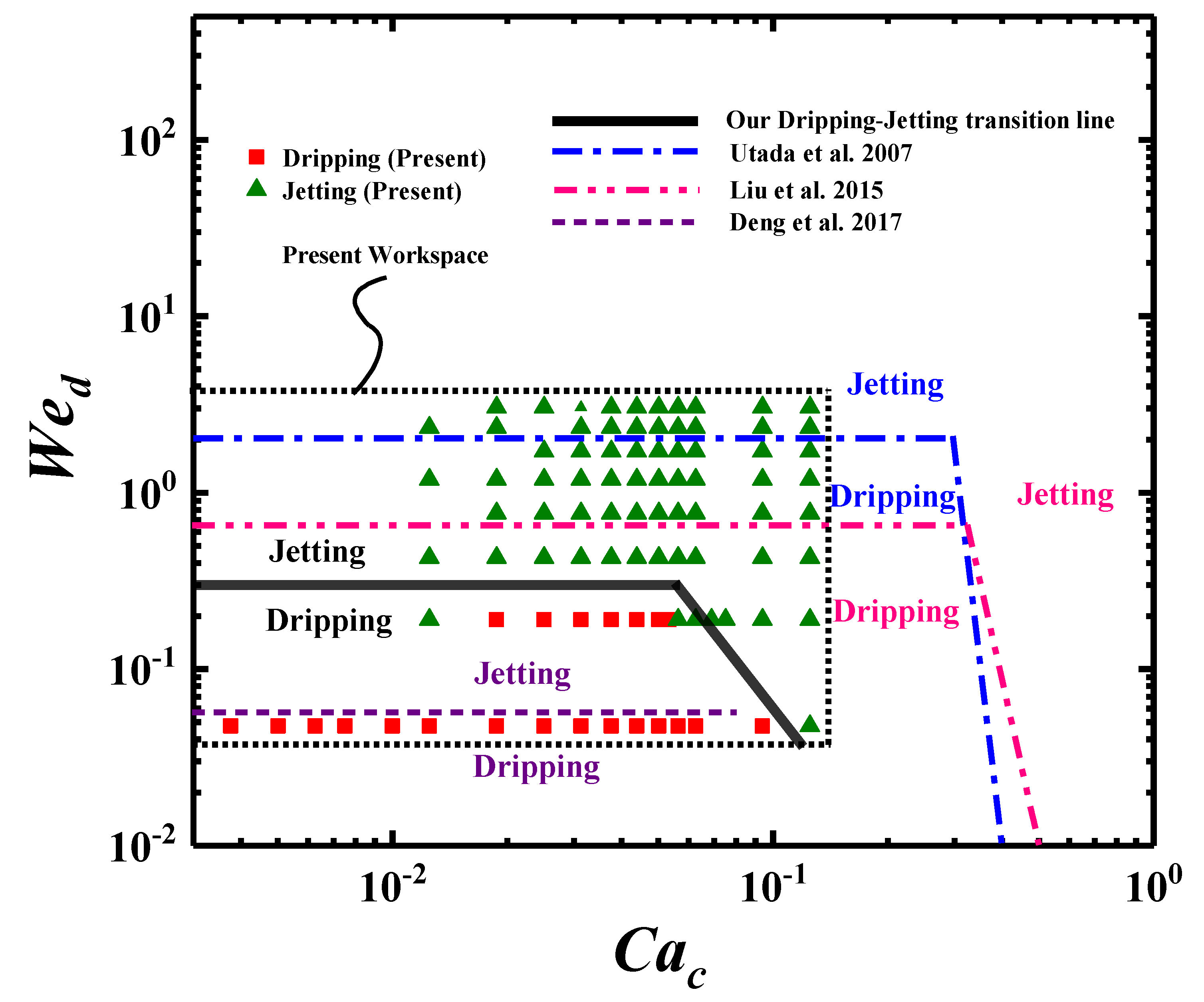
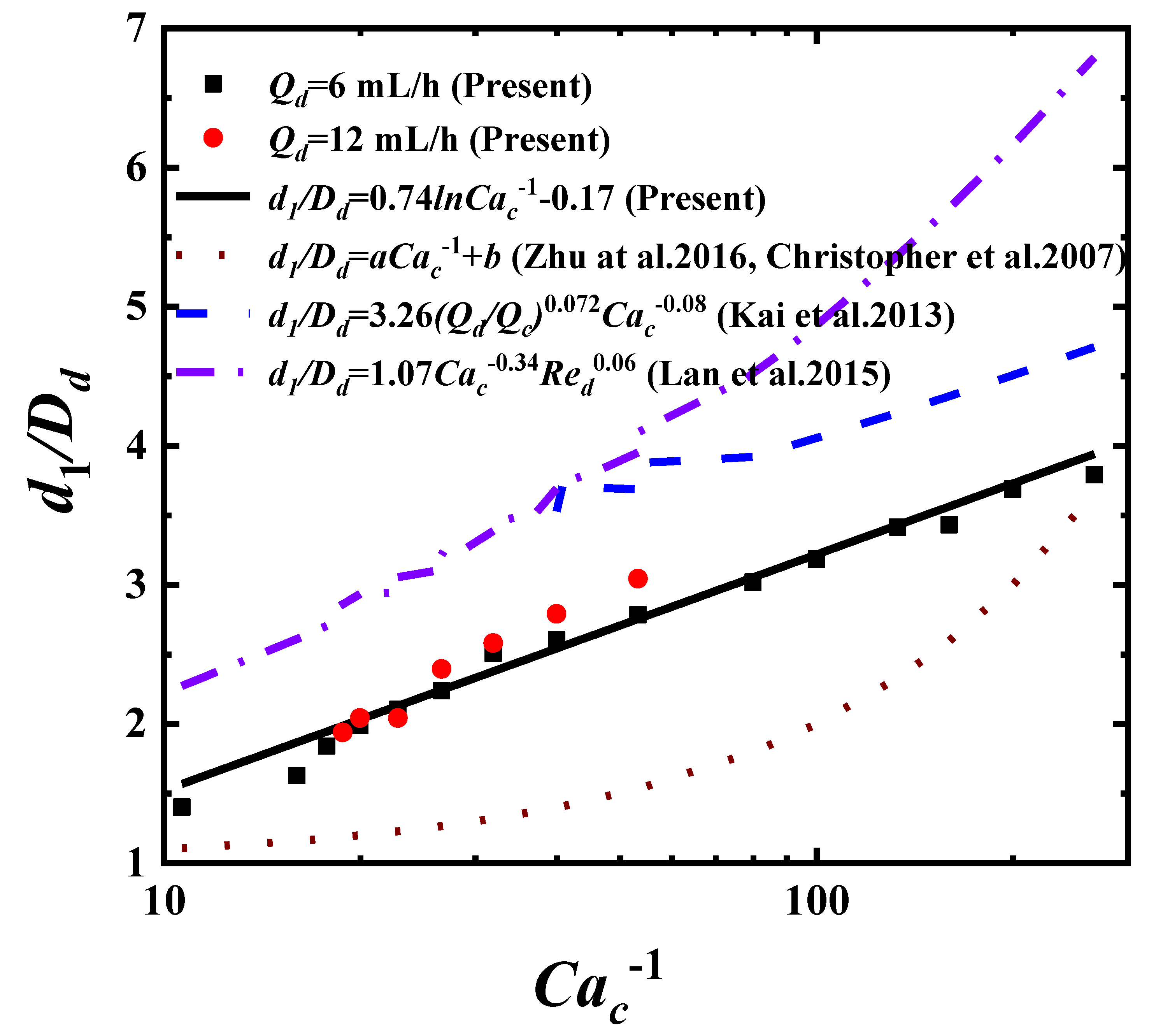
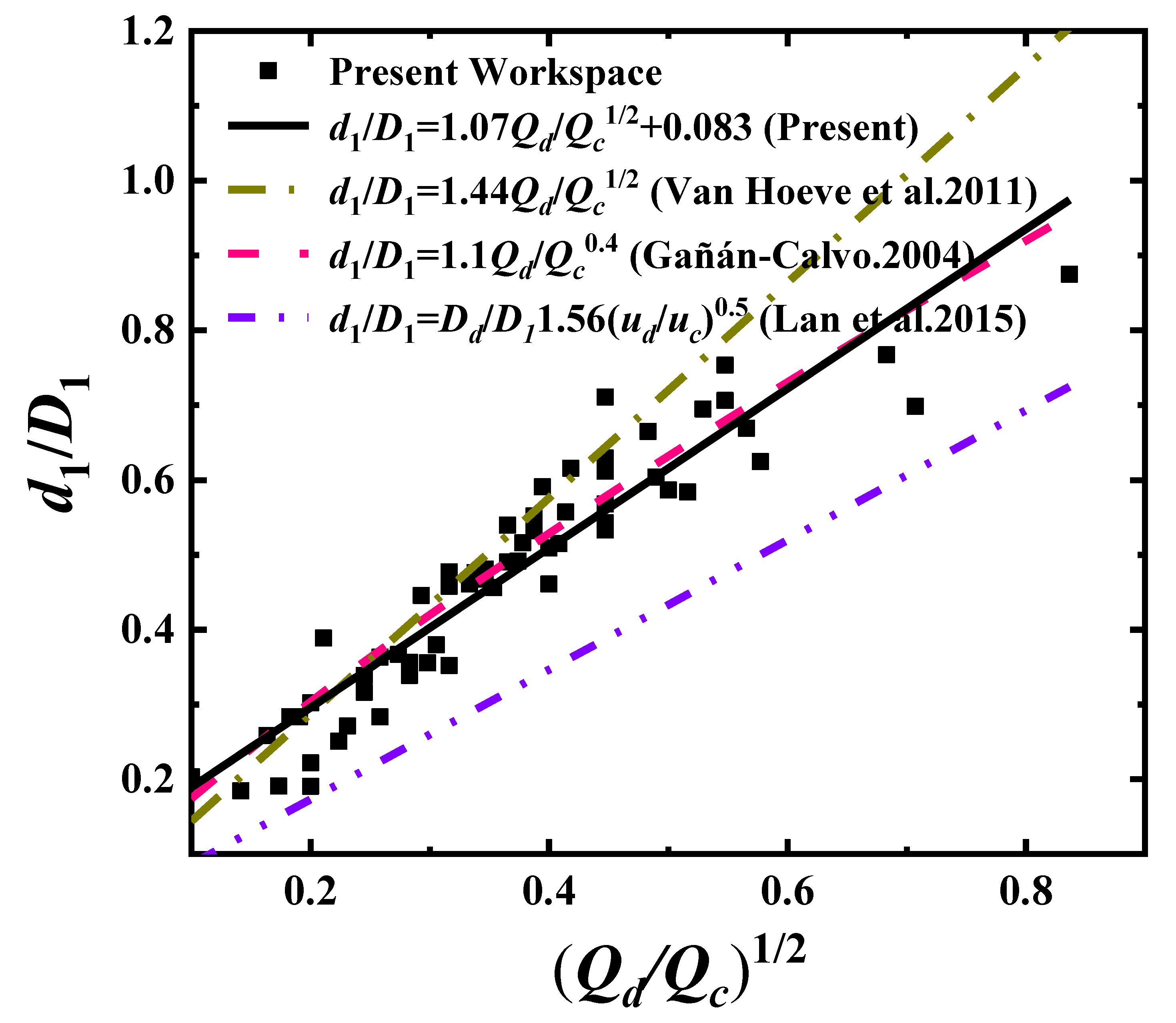
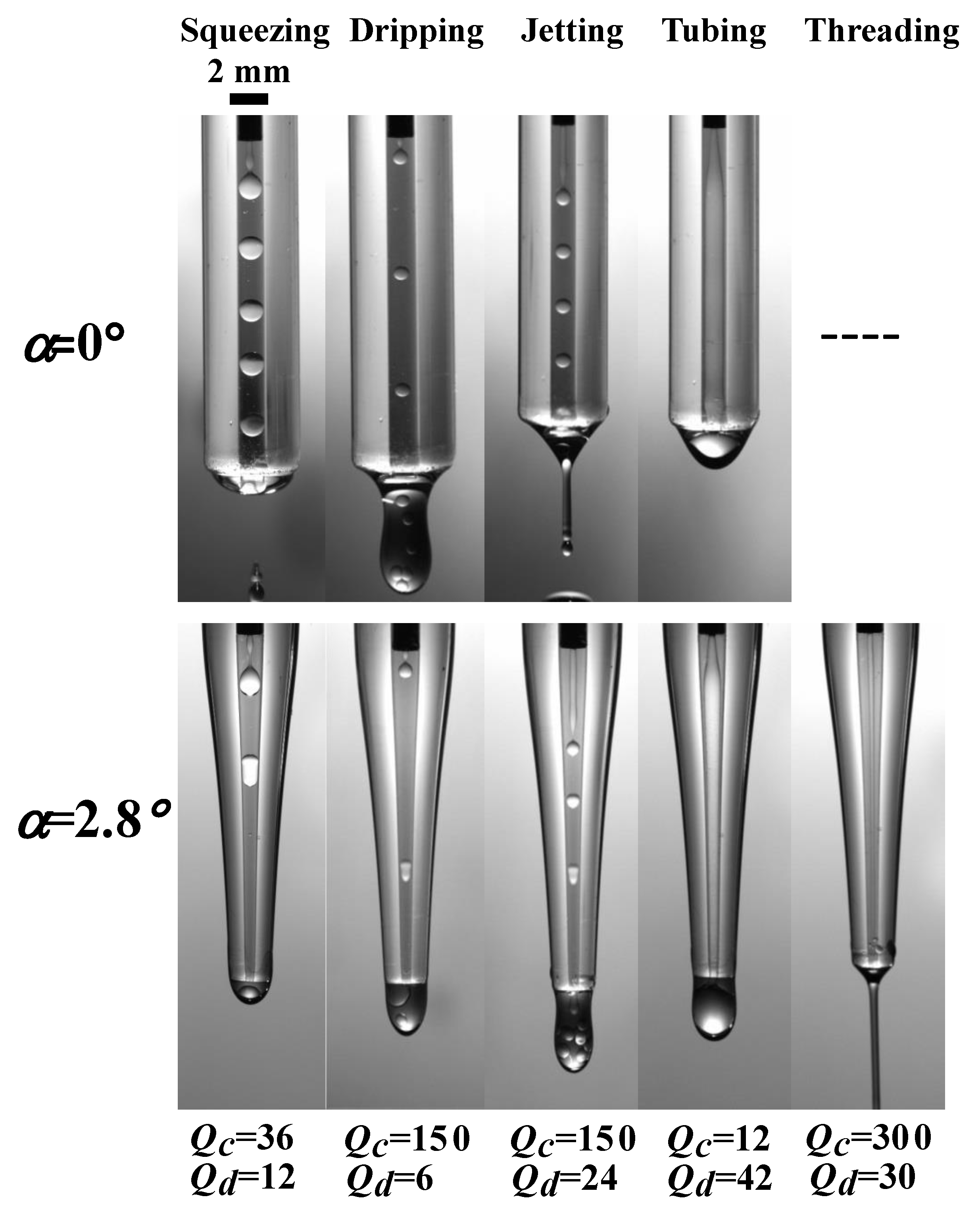
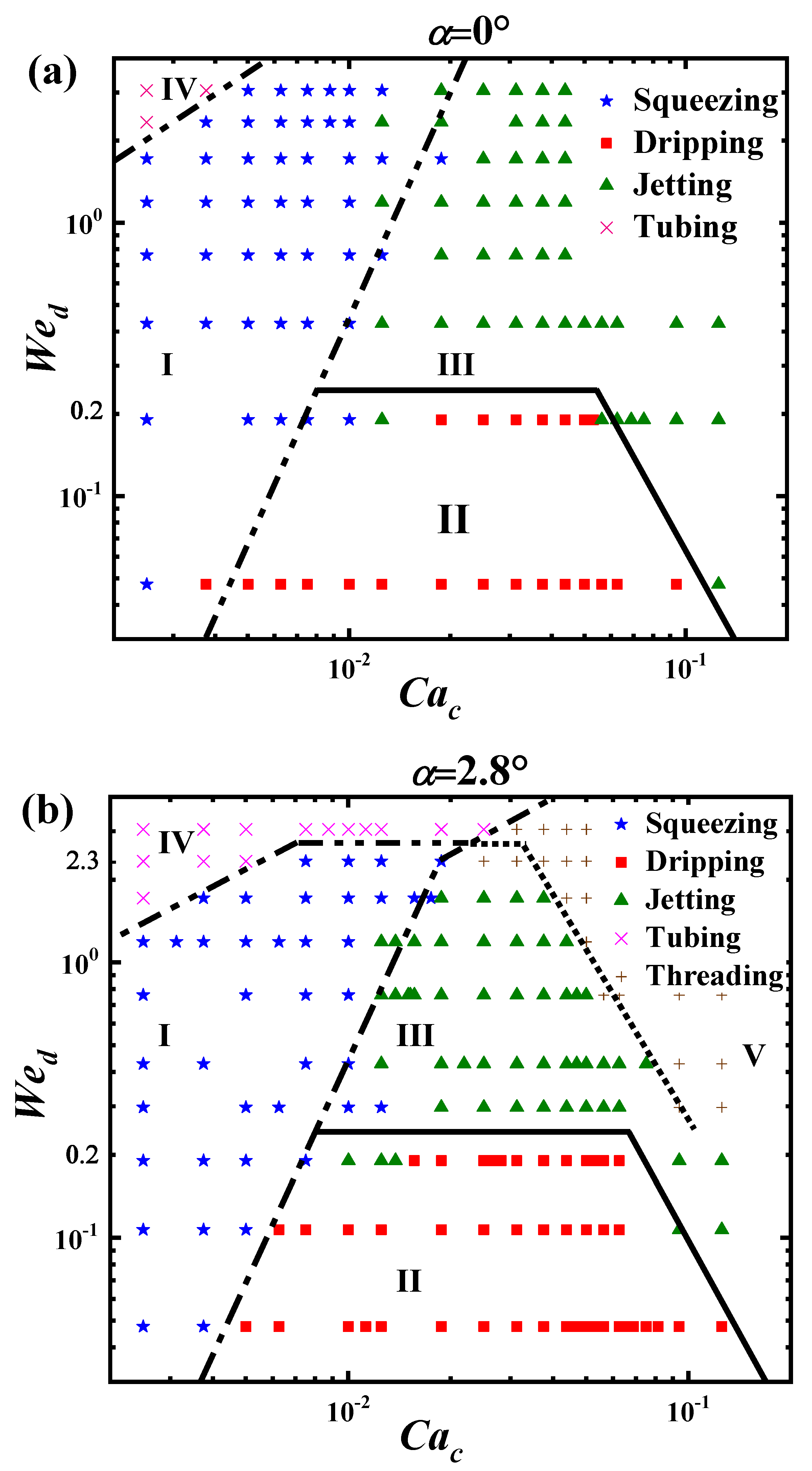
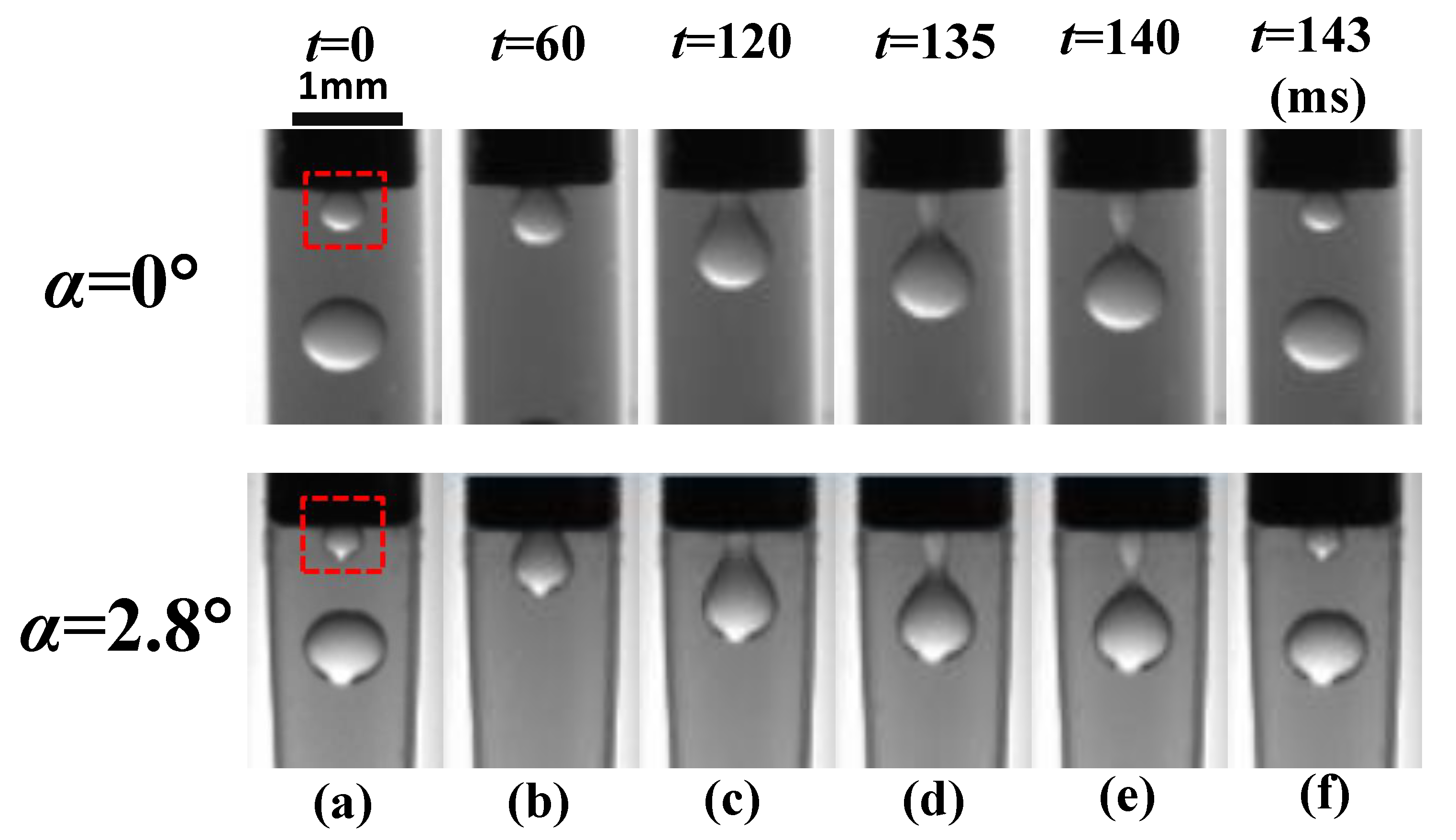
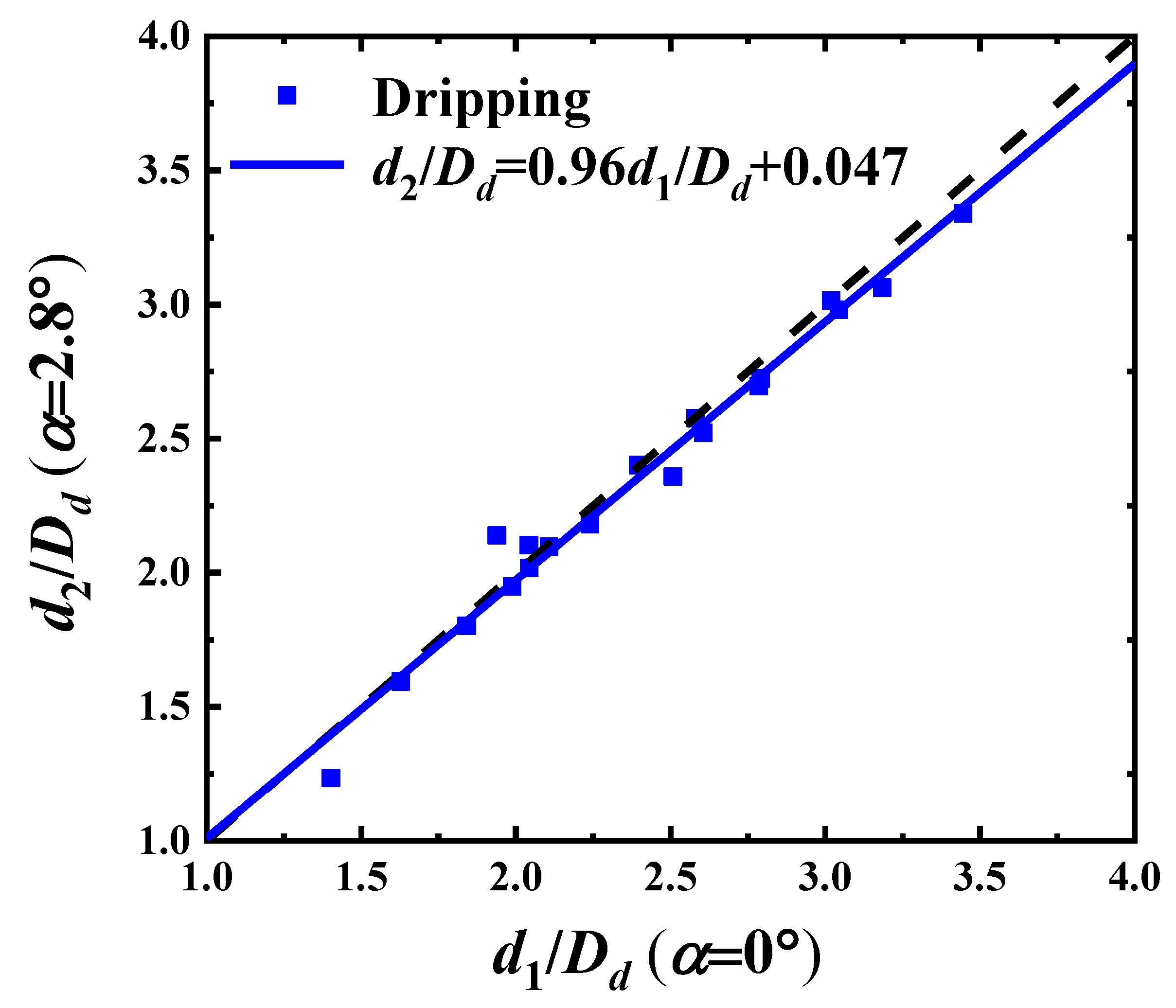
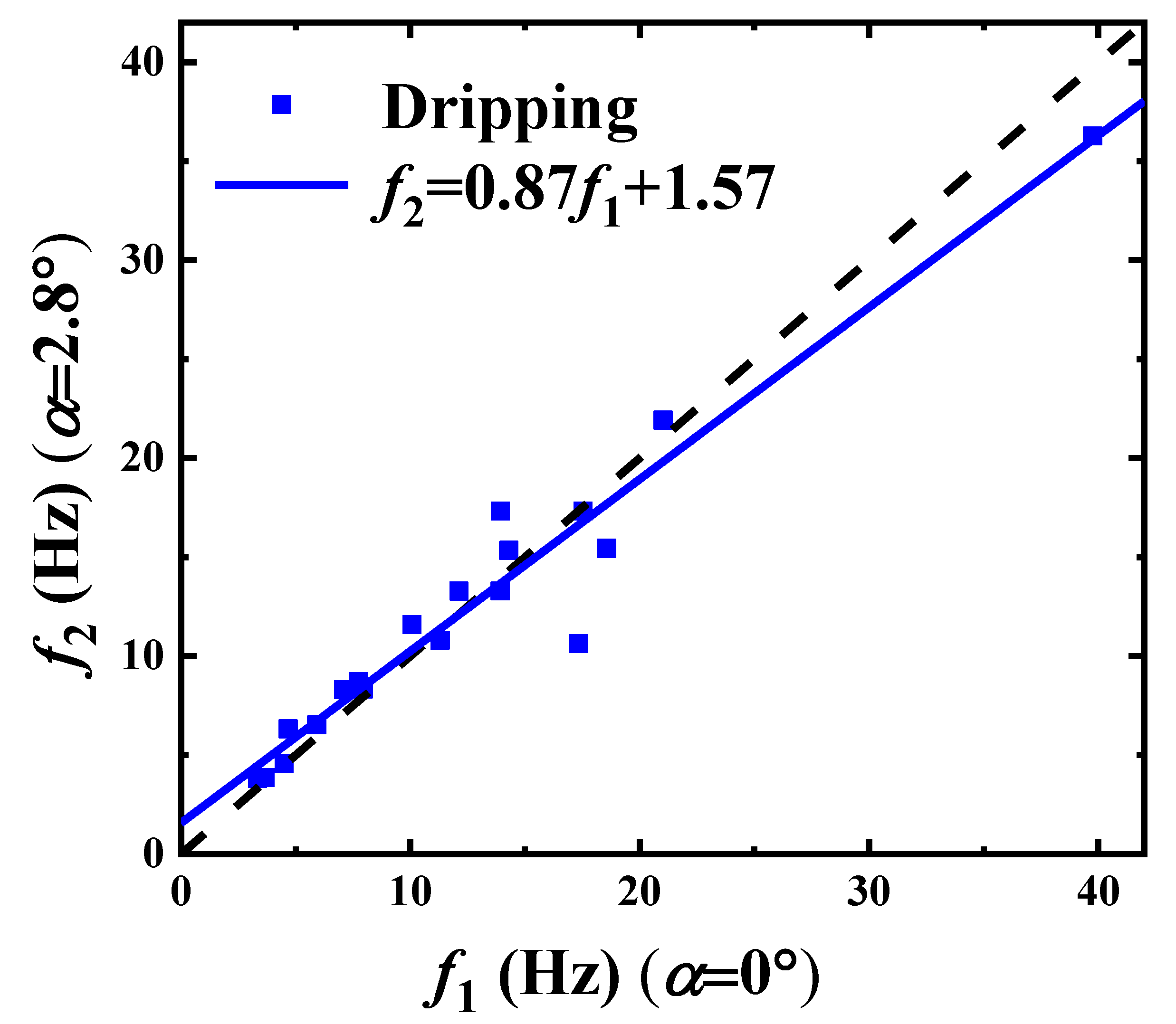
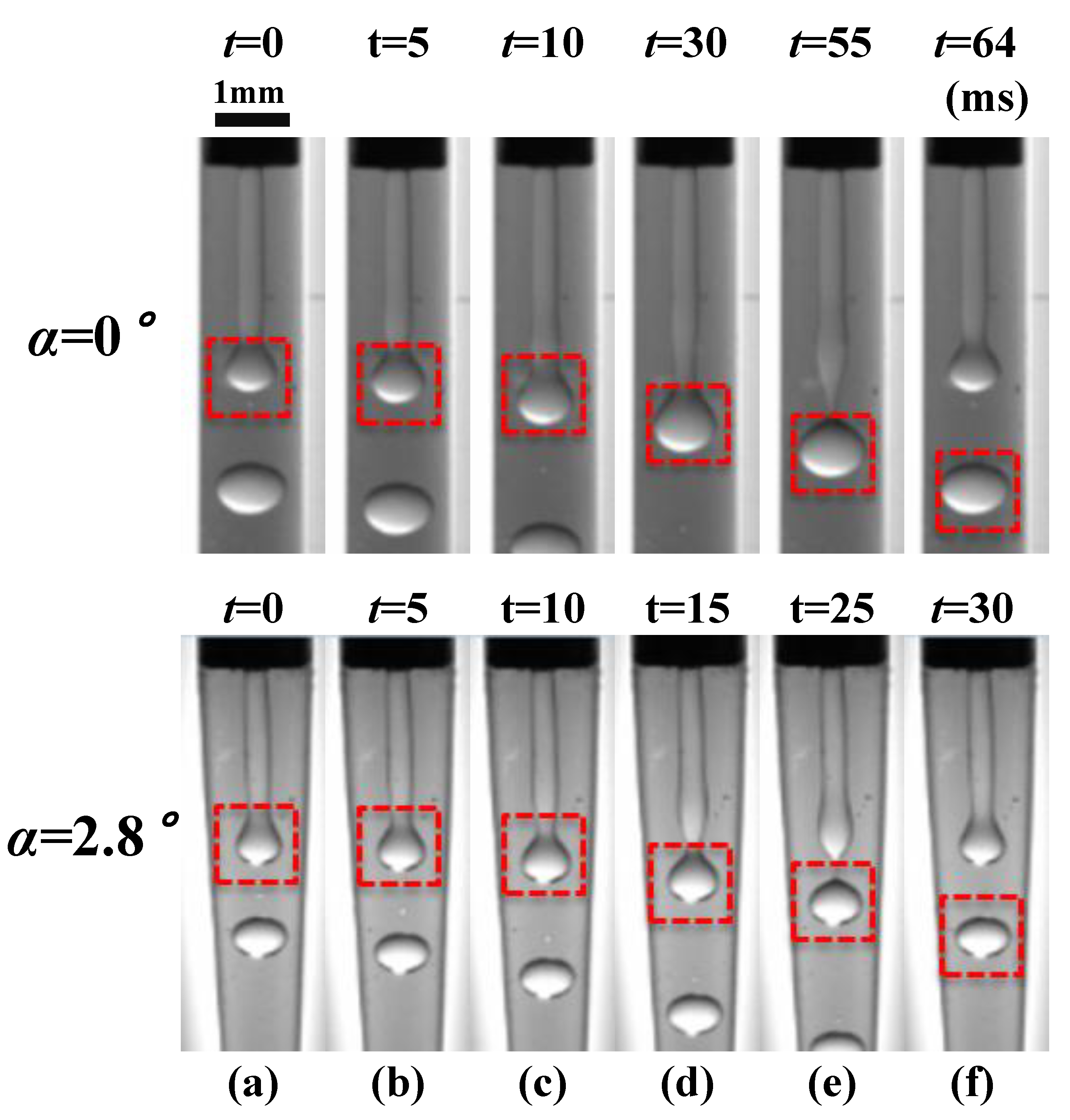

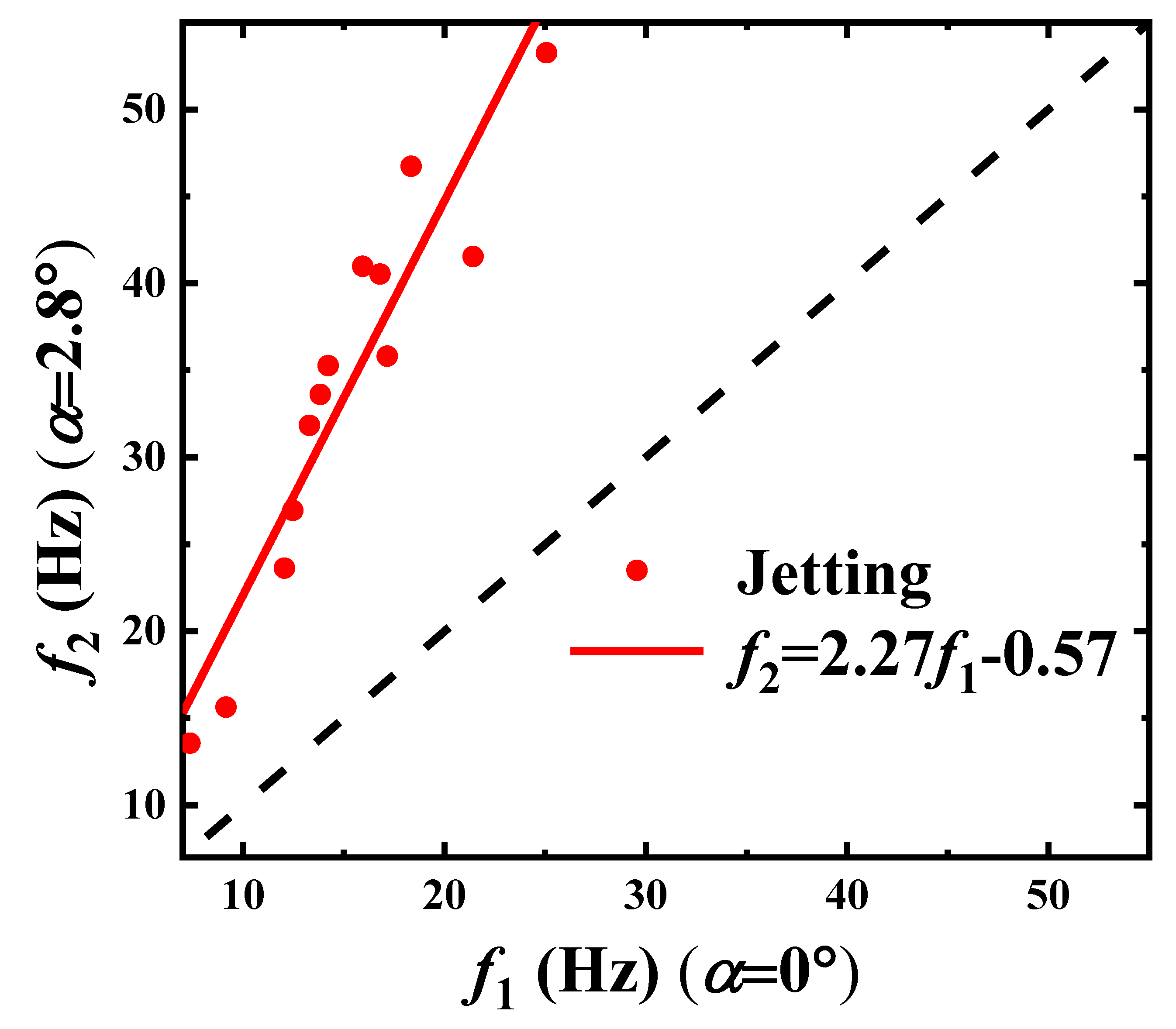
| Phase | Material | (mPa·s) | (g/cm ) | (mN/m) |
|---|---|---|---|---|
| Continuous phase | Ethanol (95 vol.%) | 1.3 | 0.817 | 4.5 |
| Dispersed phase | Liquid paraffin | 15.8 | 0.836 |
© 2020 by the authors. Licensee MDPI, Basel, Switzerland. This article is an open access article distributed under the terms and conditions of the Creative Commons Attribution (CC BY) license (http://creativecommons.org/licenses/by/4.0/).
Share and Cite
Zhang, J.; Wang, C.; Liu, X.; Yi, C.; Wang, Z.L. Experimental Studies of Microchannel Tapering on Droplet Forming Acceleration in Liquid Paraffin/Ethanol Coaxial Flows. Materials 2020, 13, 944. https://doi.org/10.3390/ma13040944
Zhang J, Wang C, Liu X, Yi C, Wang ZL. Experimental Studies of Microchannel Tapering on Droplet Forming Acceleration in Liquid Paraffin/Ethanol Coaxial Flows. Materials. 2020; 13(4):944. https://doi.org/10.3390/ma13040944
Chicago/Turabian StyleZhang, Jinsong, Chao Wang, Xianfeng Liu, Chunming Yi, and Z. L. Wang. 2020. "Experimental Studies of Microchannel Tapering on Droplet Forming Acceleration in Liquid Paraffin/Ethanol Coaxial Flows" Materials 13, no. 4: 944. https://doi.org/10.3390/ma13040944
APA StyleZhang, J., Wang, C., Liu, X., Yi, C., & Wang, Z. L. (2020). Experimental Studies of Microchannel Tapering on Droplet Forming Acceleration in Liquid Paraffin/Ethanol Coaxial Flows. Materials, 13(4), 944. https://doi.org/10.3390/ma13040944





